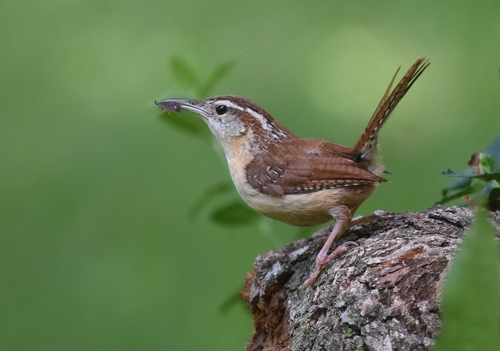
Carolina Wren
The Carolina Wren (Thryothorus ludovicianus) is a small but robust songbird common in the southeastern United States. Known for its loud, ringing song, it plays a vital role in controlling insect populations within its habitat. While not as visually striking as some birds, its rich, reddish-brown plumage and energetic behavior make it a favorite among birdwatchers. It holds no particular cultural significance beyond being a familiar and welcome backyard bird.
12.5-14 cm
Length
18-19 cm
Wingspan
Least Concern
Conservation Status
Distribution
The Carolina Wren is primarily found in the southeastern United States, extending from the Gulf Coast north to parts of the Midwest and east to the Atlantic coast. Its range reaches as far north as southern Iowa, Illinois, Indiana, Ohio, Pennsylvania and into parts of southern New England. It is a non-migratory species, maintaining its territory year-round.
Lifespan
Typically 2-6 years in the wild, though some individuals may live longer.
Carolina Wren's Habitat
Habitat Types
Deciduous forests, Mixed woodlands, Suburban gardens, Thickets, Wooded ravines
Climate Zones
Temperate, Subtropical
Adaptations
Carolina Wrens are well-adapted to dense undergrowth, using their strong legs and short, rounded wings to navigate through thick vegetation. Their inquisitive nature allows them to exploit a variety of food sources and nesting sites.
Variations
Several subspecies are recognized, differing slightly in plumage color and size. These variations are subtle and often require expert observation to distinguish.
Appearance
Breeding Plumage
Plumage remains largely the same throughout the year.
Seasonal Feather Changes
Minimal seasonal variation.
Sex Based Plumage Differences
Males and females have very similar plumage.
Notable Features
Prominent white eyebrow stripe, Reddish-brown upperparts, Buffy-orange underparts, Dark barring on wings and tail
Diet and Feeding
Primary Foods
Insects, Spiders, Beetles, Caterpillars, Small fruits and seeds (occasionally)
Foraging Behavior
Carolina Wrens forage actively on the ground and in low vegetation, probing under leaves, bark, and debris for insects and spiders. They are often seen hopping and flitting through underbrush.
Specializations
Their slightly decurved bill is well-suited for probing into crevices and extracting insects.
Seasonal Diet Variations
While primarily insectivorous, they may consume more seeds and berries during colder months when insect availability is reduced.
Behavior
Social Structure
Carolina Wrens are typically found in pairs or family groups. They are territorial, especially during the breeding season.
Communication
Loud, varied songs, often described as "tea-kettle, tea-kettle, tea-kettle", Chattering calls, Scolding calls when alarmed
Migration
Non-migratory; they are year-round residents within their range.
Territorial or Group Behaviors
Pairs defend their territories vigorously against intruders, using vocalizations and displays. They are known to be curious and will readily investigate new objects or sounds in their territory.
Conservation
Threats
Habitat loss due to urbanization and deforestation, Severe winters can cause population declines, Pesticide use (indirectly, through reduction of insect prey)
Protection Programs
Not Evaluated
Local National Laws
Protected under the Migratory Bird Treaty Act in the United States.
Population Trend
Stable
Population Estimates
The global population is estimated to be around 14 million individuals.
Interesting Facts
Carolina Wrens often build nests in unusual places.
They have been known to nest in old boots, flowerpots, mailboxes, and other human-made objects.
They can sing dozens of different song variations.
Males have a large repertoire of songs, which they use to defend their territory and attract mates.
They are the state bird of South Carolina.
Chosen for its cheerful song and year-round presence.
Faqs about Carolina Wren
What do I do if I find a baby Carolina Wren?
If the bird appears injured or truly orphaned, contact a local wildlife rehabilitator. Otherwise, it's best to leave it alone, as the parents are likely nearby.
How can I attract Carolina Wrens to my yard?
Provide dense shrubbery, a source of fresh water, and consider leaving leaf litter undisturbed. Avoid using pesticides.
Do Carolina Wrens use birdhouses?
They may use birdhouses, especially those with a larger opening or a more open design, but they often prefer natural cavities or unconventional nesting sites.
Copyright @ Nature Style Limited. All Rights Reserved.
 English
English